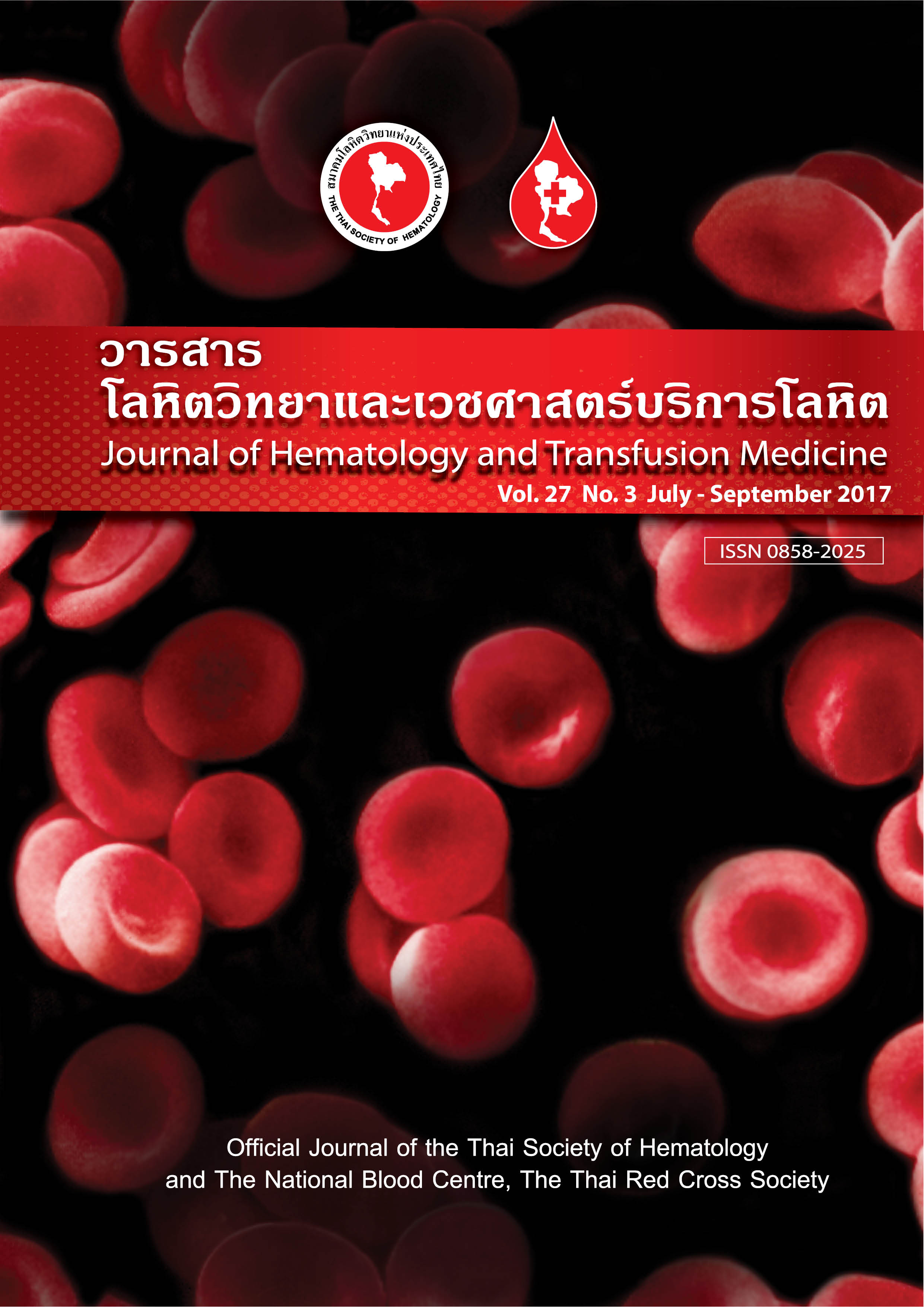The Availability of LCT-Crossmatched Platelets for Patients with Platelet Refractoriness
Keywords:
Platelet refractoriness, Lymphocytotoxic test, Crossmatched plateletAbstract
Abstract:
Background: Platelet refractoriness is defined as the repeated failure to obtain satisfactory response to platelet transfusion which is the cause of serious clinical complication usually found in multi-transfused patients. There are many causes of platelet refractoriness that can be divided into immune and non-immune. The main immune cause ishuman leukocyte antigens (HLA) alloimmunization. Other immune causes include human platelet antigens (HPA) alloimmunization and ABO incompatibility. Many strategies are used to provide appropriate or compatible platelet units for alloimmunized patients. Objective: To evaluate the availability of crossmatch-compatible platelets by lymphocytotoxicity test (LCT) for patients with platelet refractoriness and its association with panel reactive antibody (PRA) of LCT tests. Materials and Methods: Altogether, 1,316 laboratory record data of the patients with immune platelet refractoriness who requested for HLA antibody detection and crossmatch-compatible platelet for transfusion were retrospectively reviewed. An available request was defined that the number of compatible platelet units should be more than 1 therapeutic dose, which was 10 kg body weight/unit of platelet concentrate (PC) or 1 unit of single donor plateletpheresis (SDP). Results: Of 1,077 requests for compatible platelets from 128 patients, 86.4% could be responded by LCT-crossmatched compatible platelet units. However, 23 patients had never received any compatible platelet by LCT-crossmatch. Median PRA of LCT tests was significantly higher in the requests with no compatible platelet available than the requests with compatible platelets [96 (0.86-1.00) VS 0.34 (0.01-0.67), p < 0.01]. The panel reactivity of greater than or equal to 70% was significantly associated with the unavailability of compatible platelets. Conclusion: LCT-crossmatched compatible platelet transfusion was available for the majority of patients with alloimmune platelet refractoriness.
บทคัดย่อ
บทนำ ภาวะเกล็ดเลือดต่ำที่ไม่ตอบสนองต่อการให้เกล็ดเลือด (Platelet refractoriness) หมายถึง ภาวะที่เกิดจากการให้เกล็ดเลือดแก่ผู้ป่วยซ้ำแล้วนับจำนวนเกล็ดเลือดภายหลังการให้จะไม่เพิ่มขึ้นเท่าที่ควรทำให้เกิดภาวะแทรกซ้อนทางการแพทย์อย่างรุนแรง พบในผู้ป่วยที่ได้รับเลือดและหรือเกล็ดเลือดเป็นประจำ สาเหตุที่ทำให้เกิดplatelet refractoriness มีทั้ง immune และ non-immune สาเหตุส่วนใหญ่ของ immune มาจากการถูกกระตุ้นให้สร้างแอนติบอดีต่อ human leukocyte antigen (HLA) ส่วนสาเหตุอื่นๆได้แก่ การถูกกระตุ้นให้สร้างแอนติบอดีต่อ human platelet antigen (HPA) และการได้รับเกล็ดเลือดซึ่งมีหมู่เลือด ABO ไม่ตรงกัน การรักษาเพื่อให้ได้ผลดีจึงควรให้เกล็ดเลือดที่เข้ากันได้ให้กับผู้ป่วยเหล่านี้ วัตถุประสงค์ เพื่อประเมินความสามารถในการหาเกล็ดเลือดที่เข้ากันได้สำหรับผู้ป่วยที่มีภาวะเกล็ดเลือดต่ำที่ไม่ตอบสนองต่อการให้เกล็ดเลือดโดยการทดสอบความเข้ากันได้ด้วยวิธีลิมโฟไซโตท็อกซิกซิตีย์ และศึกษาความสัมพันธ์กับ panel reactive antibody (PRA) วัสดุและวิธีการ ศึกษาข้อมูลย้อนหลังจำนวน 1,316 ข้อมูลของผู้ป่วยที่มีภาวะเกล็ดเลือดต่ำที่ไม่ตอบสนองต่อการให้เกล็ดเลือด ซึ่งมีการขอให้ตรวจหา HLA antibody และขอ crossmatch-compatible plateletโดยการมีเกล็ดเลือดที่เข้ากันได้ให้ผู้ป่วยหมายถึงจะต้องมีผลการตรวจที่ได้ปริมาณเกล็ดเลือดที่เข้ากันได้ด้วยการทดสอบความเข้ากันได้ด้วยวิธีลิมโฟไซโตท็อกซิกซิตีย์เพียงพอต่อการรักษาด้วยการให้เกล็ดเลือด 1 ครั้ง ซึ่งถ้าเป็นการให้ platelet concentrate (PC) จะให้ในขนาดน้ำหนักตัวผู้ป่วย 10 กิโลกรัมต่อ PC 1 ยูนิตหรือหากเป็น single donor plateletpheresis (SDP) จะให้ในขนาด 1 ยูนิตต่อครั้ง ผลการศึกษา สามารถหาเกล็ดเลือดที่เข้ากันได้จากการทดสอบความเข้ากันได้ด้วยวิธีลิมโฟไซโตท็อกซิกซิตีย์ได้ร้อยละ 86.4 ของการขอเกล็ดเลือดทั้งหมด 1,077 ครั้ง จากผู้ป่วย 128 คน อย่างไรก็ตามมีผู้ป่วยจำนวน 23 คนที่ไม่สามารถหาเกล็ดเลือดที่เข้ากันได้จากการทดสอบด้วยวิธีนี้ เมื่อศึกษาเปรียบเทียบผล PRA พบว่าในการทดสอบที่เกล็ดเลือดเข้ากันไม่ได้มีค่าสูงกว่าการทดสอบที่มีเกล็ดเลือดเข้ากันได้อย่างมีนัยสำคัญทางสถิติ [96 (0.86-1.00) vs 0.34 (0.01-0.67), p < 0.01] ซึ่งการมีผล PRA ที่มากกว่าหรือเท่ากับร้อยละ 70 มีความสัมพันธ์กับการหาเกล็ดเลือดที่เข้ากันไม่ได้อย่างมีนัยสำคัญทางสถิติ สรุปสามารถหาเกล็ดเลือดที่เข้ากันได้ให้ผู้ป่วยที่มีภาวะเกล็ดเลือดต่ำที่ไม่ตอบสนองต่อการให้เกล็ดเลือดส่วนใหญ่ได้โดยการทดสอบความเข้ากันได้ด้วยวิธีลิมโฟไซโตท็อกซิกซิตีย์



